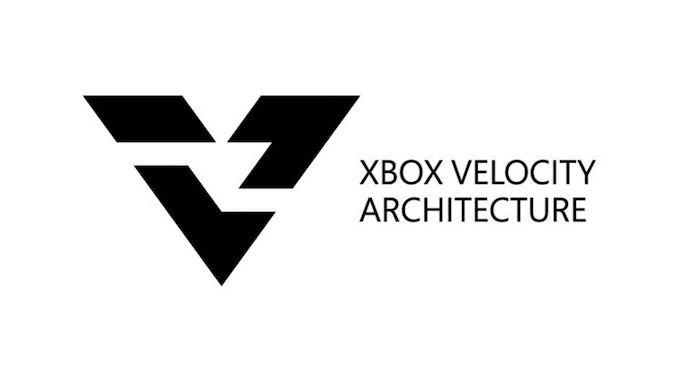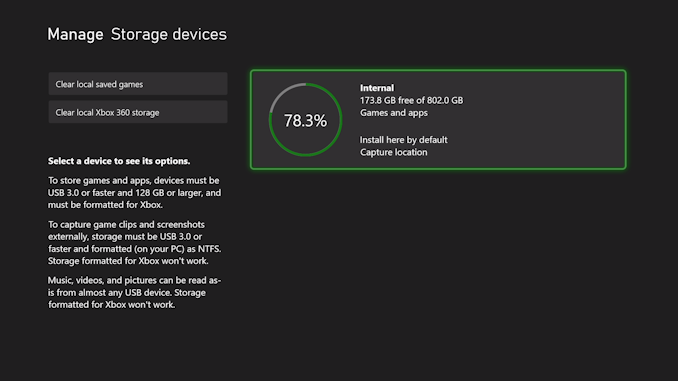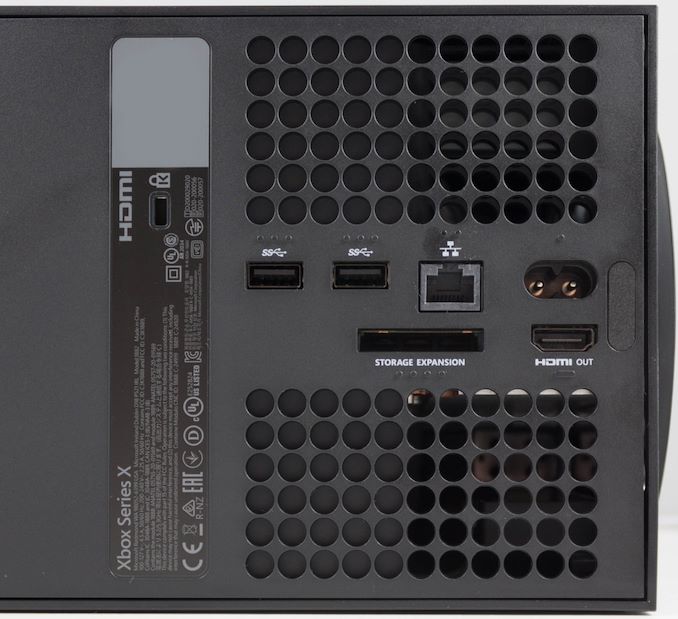The Xbox Series X Review: Ushering In The Next Generation of Game Consoles
by Brett Howse on November 5, 2020 9:00 AM ESTXbox Velocity Architecture
A lot of buzz has been made about the fact that both Microsoft and Sony have moved to solid-state storage with this round of consoles, and for good reason. Flash-based storage offers far more performance than the spinning hard disk drives that came before, in both sequential read/write, as well as random read/write. That being said, Microsoft and Sony have taken different approaches to the task, with Sony opting to put a lot of their eggs in bleeding-edge storage performance, and Microsoft opting for more conventional flash storage with their own tweaks in hardware to suit a console workload. Each will have its own advantages and disadvantages, but no matter what anyone thinks, you can’t drive pixels with a SSD, so Microsoft opting to put more of their Xbox budget into the GPU is not a bad thing.
For a complete breakdown on what each company is doing, please check out this article Billy Tallis wrote in June, explaining each company's storage decisions and the rationales behind them.
The move to SSD storage brings about a world of improvements to the Xbox Series X, and Microsoft has dubbed their storage implementation the Xbox Velocity Architecture. This encompasses four key components, the first of which is the NVMe SSD itself which can handle 2.4 GB/s of uncompressed data. But to connect it to the system, and reduce CPU overhead, there is also a hardware decompression block, an new API called DirectStorage, and Sample Feedback Streaming, which allows games to load into memory only the exact portions of textures required to actually render a scene. A single 4K-quality texture is around 8 MB in size – even with texture compression – so being able to grab portions of textures as needed will reduce the strain on the SSD and the memory pool. Microsoft calculates that Sample Feedback Streaming on its own is an average 2.5x multiplier on how much memory is in the console, and the same 2.5x on SSD performance.
All this SSD performance brings a lot of benefits. The first one you will notice is the boot time.
With the Xbox Series X in its Energy-Savings mode, which means it is fully powered off, it boots up to the dashboard, ready to play, in just eight seconds. You read that correctly: eight seconds for a cold boot. Compare that to the Xbox One X.
The older console with a rotating rust hard drive clocks in a hair under a minute to go from fully off to ready to use. The speed difference is staggering and changes the way you can use the console. Both generations offer an “instant-on” mode, which puts the console to sleep instead of off, allowing for much faster resume times of just a few seconds, but at the cost of extra power draw while sleeping. The Xbox Series X boots so fast that you can get the benefit of being powered-down without sacrificing the boot time. That is a nice change.
Load times for games are also dramatically improved. With the move to 4K gaming on the Xbox One X, load times took a noticeable hit as the textures required for higher-resolution gaming are much larger than 1920x1080 textures. A game like Forza Motorsports 7 would take minutes to load tracks, which is now done in a handful of seconds.
There is no overstating how much of an impact this has on a gaming session. Waiting minutes for a track to load is not an immersive experience.
The beauty of moving to NVMe flash storage is that all existing games will benefit with no work required by the developer. Load times will be reduced, and owners will enjoy the benefits. Another great example of this is Red Dead Redemption 2, which also took minutes to load on the Xbox One X.
This is not quite as instantaneous as the Forza 7 example, since RDR2 is such a massive game, but it certainly makes for a much more enjoyable experience when having to load the game from the beginning.
But what if you did not have to load the game from the beginning at all? The Xbox Series X|S, thanks to the great performance of the storage, are implementing a feature called Quick Resume. If you owned a previous generation console, you are likely aware that if you closed a game by going to the home screen, the game was suspended in memory. As long as you did not open another game, you could go back to that game, even if the console was powered off and Instant-On mode was set, as the memory would be active and the game would be instantly available right where you left off. Thanks to the extra performance from the solid-state drive, Quick Resume will quickly write the active contents of the game’s memory to storage. The entire contents of memory can be written to storage in just a couple of seconds, and when loading from memory, it also just takes a couple of seconds to get back to exactly where you left off, even if the console was completely powered off.
No developer involvement is required for Quick Resume either, so this feature is available across all games, including Xbox One games via backwards compatibility. This is one of the key features that really makes you sit up and take notice. You can switch between active games in just a couple of seconds and be back to exactly where you were. It is a liberating feeling.
With 2.4 GB/s sustained raw performance, and 4.8 GB/s of compressed data transfer speeds, the new Xbox Velocity Architecture is the most noticeable change when moving from a previous generation console to the Xbox Series X. As games evolve, worlds should be able to be even larger, as developers will be able to swap textures more quickly in and out of memory as needed.
The Xbox Series X is currently a 1 TB console, and the Xbox Series S ships as a 512 GB console. Those numbers are, as is unfortunately industry practice, base 10 values instead of base 2. Plus, the system itself must reserve some of the space for the operating system and storage for game files and such. The Xbox Series X offers 802 GB of unused storage for game and app downloads, and the Series S has 364 GB usable. Unfortunately, due to the console and games expecting NVMe storage, using a USB hard drive for additional storage is no longer as simple of an option. Games can still be stored on USB drives, but titles specifically enhanced for the X|S architecture can only be run off of the internal storage, so some fussing around may be required to keep games in long-term storage on USB drives, and then swap them to internal when needed.
The other option is to increase the NVMe storage. Microsoft has opted to allow an add-in card for additional storage via a connector on the back of the Xbox. Currently, there is a 1 TB expansion option from the long-time Xbox partner Seagate. If and when other options will be available is unknown, but if you absolutely need more storage, an extra 1 TB is a decent amount. You would have to think that the amount available, as well as pricing, will drop over time, but it is not a standard M.2 PC part, so prices will always carry a premium.
The faster storage will not outright create better graphics, although it should allow game worlds to become more expansive. But, the quality of life improvements that have come to the Xbox Series X, thanks to the Xbox Velocity Architecture, really changes the way the console can be used, and the differences can not be understated. Everything is faster, from boot times, to loading times, and add in the new Quick Resume function, and gaming is far more enjoyable on the Xbox Series X than it ever was on any previous Xbox.
AV Connections
Better graphics, faster storage, and a weird shape. The Xbox Series X has a lot going for it, but how do you actually connect it to your TV? As already mentioned, the Xbox Series X|S has dropped the HDMI input, but as a reward (not really) you get an HDMI 2.1 output. HDMI 2.1 allows for 4K output at 120 Hz, unlike HDMI 2.0 which was capped at 60 Hz. It also allows for 8K video, although most people do not have an 8K TV yet, and there is almost no content for that.
The Xbox Series X|S, like the outgoing model, also support variable refresh rates, so if you TV or monitor supports it, you can get even smoother framerates. Most televisions do not support this yet, although some of the most recent devices do support variable refresh rates / FreeSync, as well as 120 Hz inputs.
The Xbox Series X|S also supports an automatic low-latency mode (ALLM) which will switch the TV to its lowest latency input when you start playing if the television supports it. Xbox One also supported this functionality.
Audio also gets a slight change. The Xbox has dropped the S/PDIF audio output and relies completely on HDMI for the audio stream. S/PDIF has long since been replaced with HDMI as it could not handle the bitrate required for the more modern lossless audio codecs and 7 channel surround, so this is not a surprise, but if you were hoping to leverage optical audio to connect to a receiver, you will sadly be out of luck.
Microsoft has put a fair amount of extra silicon into their SoC just to handle audio, with games being able to support positional audio such as Dolby Atmos and DTS:X, and developers will be able to leverage Microsoft’s Project Acoustics as well thanks to the new audio hardware baked into the silicon. As an aside, there are reports that the Xbox Series X|S will not work with certain receivers with HDMI 2.1, as their included hardware is incompatible. The issue is not with the Xbox though, but non-compliant hardware in the receivers themselves. Be aware of the issue if you currently own an HDMI 2.1 compliant receiver though and were hoping to get 120 Hz 4K video from the Xbox.













68 Comments
View All Comments
eastcoast_pete - Saturday, November 7, 2020 - link
You're correct, and Brandon was outstanding in this movie (by Elia Kazan, I believe). Thought Stallone did borrow that line for Rocky, but it's been a while that I watched it. That being said, the "S" is at risk of being the bum among consoles, and the fact that it's readily available for pre-order suggests it's not rocking many boats out there.flyingpants265 - Friday, November 6, 2020 - link
One or two of the cores are doing things not related to games.flyingpants265 - Friday, November 6, 2020 - link
What exactly is the point of the Series S? The whole point of consoles is that they're standardizedandrewaggb - Friday, November 6, 2020 - link
The trend started with the ps4 pro and xbox one x. They're still fairly standardized, same peripherals, same cpu, same gpu archicture, same software. Series S is just for 1080p only and will probably have somewhat lower quality textures because it has less ram.Shlong - Monday, November 9, 2020 - link
The Series S also doesn't have updated graphics for backward compatibility games. The graphical updates for Xbox One games will show up on Series X but not S.cmdrdredd - Monday, November 9, 2020 - link
That went out the window a while back. Now it's just a brand, the Xbox. All games using smart delivery work on any Xbox One or Series console and will use the appropriate settings and resolution for that console. Not unlike graphics settings in your PC. I could ask what the point of a RTX3070 is and the answer is the same. A lower power and cheaper alternative that is good enough for a lower resolution.eastcoast_pete - Friday, November 6, 2020 - link
Thanks for the first look/review, Brett! Question: Did you have a chance to see just how fast the USB 3.1 connection is when a. Used with an external SSD or b. a regular 7200 rpm HDD. Especially interested in getting an idea how fast or slow it is to transfer some of the games you tested back into the built-in SSD. If you haven't tested it but still have the unit, can you try it? Thanks!Brett Howse - Saturday, November 7, 2020 - link
Thanks for the question. I don't actually have a USB SSD drive to test this. I do have a slower USB HDD but I think it would end up being the bottleneck and would give unreliable results. I think whether this is worth it for you is whether you have fast internet or not.I'll still try the USB HDD this weekend and just see how it goes and let you know.
eastcoast_pete - Saturday, November 7, 2020 - link
Thanks Brett, even a regular HDD will give an initial idea. Regarding an external SSD: Maybe someone else at AT has an external SSD they can lend you? With the current pricing for the proprietary add-on SSD, a half-priced external SSD connected by USB 3.1 is an interesting alternative. Assuming the Series X supports about 350 - 400 MB/second over USB, I'd probably get a 1TB external SSD and keep an external 8 TB HDD for "cold storage".Brett Howse - Saturday, November 7, 2020 - link
Just so you are clear on this, any USB connected drive is not capable of being used for Series X|S games. It can be used for storage only. To play the new games they have to be on internal storage or on the Seagate storage drive. You'd have to shuffle games around if you want to keep them on USB.